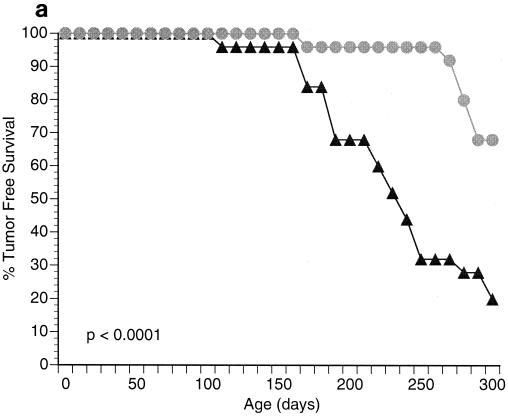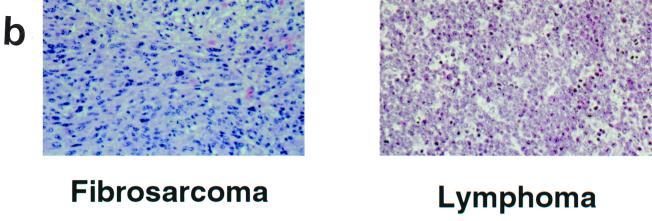FIG. 1.
Disruption of the CSB gene product reduces tumor incidence in Ink4a/ARF−/− mice. (a) Survival data for Ink4a/ARF−/− mice (triangles) versus CSB−/− Ink4a/ARF−/− mice (circles). Twenty-five Ink4a/ARF−/− mice (4 to 6 weeks old) and 25 CSB−/− Ink4a/ARF−/− mice of similar age were monitored for a total of 300 days. Points on the curve denote times when animals died or were sacrificed because of tumor formation. All deaths in this experiment were due to tumor formation. Of the 25 Ink4a/ARF−/− mice, 20 (80%) developed tumors (75% lymphomas and 25% fibrosarcomas). Of the 25 CSB−/− Ink4a/ARF−/− mice, 8 (32%) developed tumors (87% lymphomas and 13% fibrosarcomas). (b) Representative photomicrographs of the two tumor types (fibrosarcoma and lymphoma) observed in this experiment. Fibrosarcomas appeared as subcutaneous masses at various locations, including the shoulder, neck, flank, and legs. The fibrosarcomas were composed of elongated spindle cells forming whorls and bundles. Mice with lymphomas showed enlarged spleens, livers, lymph nodes, and sometimes thymuses. The lymphomas were composed of lymphoblastic cells, reticulum cells with abundant eosinophilic cytoplasm, lymphocytic mixed cells, and sometimes pleomorphic lymphoid cells.


